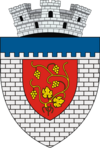Târgu Neamț
Târgu Neamț | ||
|---|---|---|
Town | ||
| ||
 Location of Târgu Neamț | ||
| Coordinates: 47°12′9″N 26°21′31″E / 47.20250°N 26.35861°E / 47.20250; 26.35861Coordinates: 47°12′9″N 26°21′31″E / 47.20250°N 26.35861°E / 47.20250; 26.35861 | ||
| Country | ||
| County | Neamț County | |
| Status | Town | |
| Government | ||
| • Mayor | Vasile Harpa (Social Liberal Union) | |
| Population (2011) | ||
| • Total | 18,695 | |
| Time zone | UTC+2 (EET) | |
| • Summer (DST) | UTC+3 (EEST) | |
| Website | http://www.primariatgneamt.ro/ | |
Târgu Neamț (Romanian pronunciation: [ˌtɨrɡu ˈne̯amt͡s]; German: Niamtz, Hungarian: Németvásár, Hebrew: נאמץ טרגו, Latin: Ante Castrum Nempch) is a town in Neamț County, Romania, on the Neamț River. It had, as of 2002[update], a population of 20,496. Three villages are administered by the town: Blebea, Humulești and Humuleștii Noi.
Contents
1 History
2 Access
3 Tourism and attractions
4 Natives
5 Gallery
6 References
History
| Historical population | ||
|---|---|---|
| Year | Pop. | ±% |
| 1912 | 9,095 | — |
| 1930 | 9,475 | +4.2% |
| 1948 | 8,948 | −5.6% |
| 1956 | 10,373 | +15.9% |
| 1966 | 12,877 | +24.1% |
| 1977 | 14,951 | +16.1% |
| 1992 | 22,282 | +49.0% |
| 2002 | 22,634 | +1.6% |
| 2011 | 18,232 | −19.4% |
| Source: Census data | ||
Originally a market town, hence its name (in Romanian "târg" = market), it had an important role in Moldavian culture. It was first mentioned in a late-14th century document.
The name neamț is derived from the Slavic word nemeti meaning "snows". In many Slavic languages, nemeti also means "German", as Germans could not understand Slavic speakers when the cultures first met. "Neamț" is also a generic name for the German people in the Romanian language.
This may lead to speculation of a German foundation of Târgu Neamț, according to which Saxon colonists crossed the Carpathians from the Bistrița area and built a commercial township. Some Romanian historians, including B. P. Hașdeu consider that Târgu Neamț was probably a Teutonic settlement from the 13th century, when the Teutonic Order made incursions from Transylvania against the Cumanic peoples that were living in Moldavia.
Nowadays, historians disagree with this possibility mostly because of the long-lasting influences of the communist-nationalistic historiography which refused to accept the town was anything else than a Romanian-founded settlement.
Access
The town is located at the crossing of two national roads: ![]() and
and ![]() . The planned East-West Motorway will bypass the town on its south when completed, providing access to Iaşi (to the east) and Târgu Mureș to the west.
. The planned East-West Motorway will bypass the town on its south when completed, providing access to Iaşi (to the east) and Târgu Mureș to the west.
The railroad station is the terminus station of CFR Line 517 linking it to Pașcani via an electrified railway.
Tourism and attractions
- The Neamț Fortress (Cetatea Neamțului) was built in the 14th century by Voivode Petru I (possibly on the ruins of a smaller Teutonic castle), and is located on the north bank of the Neamț river.
- Târgu Neamț is an appropriate starting point for trips to the monasteries in the region, located all on an average 15 km radius: Neamț Monastery, Secu, Agapia, Văratec Monastery Sihăstria and Sihla Skete. It is close to Ceahlău, Durău and Valea Bistriței.
Ion Creangă memorial house in Humulești, across Ozana river: This is the house where the famous Romanian writer was born and where he spent his childhood. The stories from Ion Creangă's masterpiece Amintiri din copilărie ("Memories of my childhood") revolve around Humulești, Târgu Neamț and in the surrounding villages.
Monumentul Eroilor (Heroes' Monument): an obelisk that commemorates the Romanian soldiers from World War I is found on Dealul Pleșu near the Pometea suburb. It commands views of the town and the mountains.
Vânători-Neamț Natural Park, housing a herd of wisent, the European bisons that once roamed the Eastern Carpathians.- Nicolae Popa ethnographic museum in Târpești[1]
Natives
- Ion Creangă
- Moshe Idel
- Irving Layton
- Gabriela Robila
- Mariana Simionescu
- Ioan Vieru
Gallery

Neamţ Citadel, located on Pleşu hill

View from Citadel

Neamţ Monastery, located 10 km west of Tg. Neamţ

Image discovered from the stove's remains in Neamț Fortress, showing Zubr/Aurochs the coat of arms of Moldova.
References
| Wikimedia Commons has media related to Târgu Neamț. |
^ http://www.romguide.net/Visit/Nicolae-Popa-Museum_vt97d






